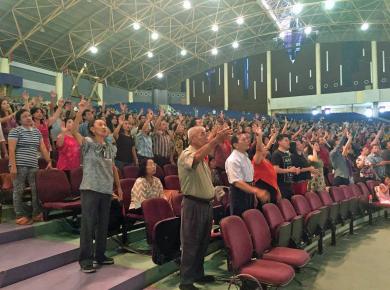Posted: June 10, 2016
In July 2009, Mennonite church leaders from Indonesia found themselves in a conversation outside a dormitory in Asuncíon, Paraguay. Although they were not strangers, their paths rarely crossed. The three groups they represented had complex histories that included separation and division.
But there in the relaxed context of the 15th Assembly of Mennonite World Conference, something significant shifted in their relationship. “We realized that all of us were of a similar age and that we shared many of the same concerns and values,” recalls David Meijanto.
For the first time, members of the group asked: Why don’t we get together more often back in Indonesia?
Microcosm of global Anabaptism
The church leaders returned to Indonesia with a commitment to meet every three months to share together and encourage each other. At one of those “Inter Menno” meetings, the idea emerged that the three groups could together host the 2021 MWC global assembly in Indonesia.
Here’s an introduction to the three synods that make up the Mennonite church in Indonesia, all shaped by the challenges of living as a tiny minority in a country with the world’s largest population of Muslims.
GITJ
GITJ (Gereja Injili di Tanah Jawa / Evangelical Church of Java) is the oldest group. The church that emerged in 1854 from work of Dutch Mennonite missionary and linguist Pieter Jansz was the first Anabaptist-Mennonite congregation in the world whose members were not primarily of European or North American origin.
An influential figure in the early history of the GITJ was Kyai Ibrahim Tunggul Wulung, a local mystic who helped enculturate the gospel message into a distinctively Javanese idiom.
Today, members of the 110 GITJ congregations tend to live in rural areas around Jepara and Puti, speak Javanese, work as labourers and worship in a somewhat formal liturgical style.
GKMI
The GKMI (Persatuan Gereja-Gereja Kristen Muria Indonesia / Union of Muria Christian Churches of Indonesia) traces its roots to Chinese immigrants who settled in Java in the early 20th century.
In 1917, Tee Siem Tat, a Chinese businessman, became a Christian when he and another family member were miraculously healed after listening to Gospel stories.
The resulting congregations’ Anabaptist identity was strengthened in the 1950s and 1960s, when Hermann Tann consciously worked to introduce Mennonite theology and polity.
Today, some 55 congregations make up the GKMI. Its members tend to be of Chinese background, well-educated and strongly committed to missions.
JKI
JKI (Jemaat Kristen Indonesia / Christian Congregations of Indonesia) emerged in the late 1970s as a charismatic renewal movement within the GKMI.
Led by Adi Sutanto, a small GKMI prayer group began to incorporate speaking in tongues, faith healing, visions and prophecy into their regular worship. JKI, formed in 1985, has since grown to include 155 congregations, including several in the United States, Australia and the Netherlands.
The best-known JKI church combines charismatic worship with social ministries and a strong outreach program in the city of Semarang. This 20,000-member “Holy Stadium” is the likely site of the MWC assembly in 2021.
Today, leaders of these three synods are looking beyond their differences to seek new partnerships with each other and with the larger Mennonite world. MWC Assembly 2021 will offer a great perspective on the various ways that Anabaptism has taken root in Indonesia.
It’s not too soon to put it on your calendar. TM
—John D. Roth, MWC Faith and Life Commission, secretary; professor of history at Goshen College, Indiana, USA; director of the Institute for the Study of Global Anabaptism
This article originally appeared in the April edition of The Mennonite magazine, published by Mennonite Church USA.



Join the Conversation on Social Media
FacebookTwitterInstagramFlickrYouTube